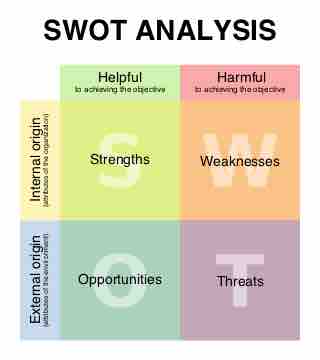A method of analyzing the environment in which businesses operate is referred to as a context analysis. One of the most recognized of these is the SWOT (strengths, weaknesses, opportunities, and threats) analysis. Performing a SWOT analysis allows a business to gain insights into its internal strengths and weaknesses and to relate these insights to the external opportunities and threats posed by the marketplace in which the business operates. The main goal of a context analysis, SWOT or otherwise, is to analyze the business environment in order to develop a strategic plan.
SWOT and Strategy
A SWOT analysis is a strategic planning method used to evaluate the strengths, weaknesses, opportunities, and threats related to a project or business venture. A SWOT assessment involves specifying the business's objective and then identifying the internal and external factors that are favorable and unfavorable toward the business's ability to achieve its objective. Setting the objective, in terms of moving from strategy planning to strategy implementation, should be done after the SWOT analysis has been performed. Doing so allows the organization to set achievable goals and objectives.
Components of SWOT
- Strengths: internal characteristics of the business that give it an advantage over competitors
- Weaknesses: internal characteristics that place the business at a disadvantage against competitors
- Opportunities: external chances to improve performance in the overall business environment
- Threats: external elements in the environment that could cause trouble for the business

SWOT analysis
The SWOT analysis matrix illustrates where the company's strengths and weaknesses lie relative to factors in the market. Strengths and opportunities (the S and O of SWOT) are both helpful toward achieving company objectives, but strengths originate internally while opportunities originate externally. Similarly, weaknesses and threats (the W and T of SWOT) are harmful toward achieving objectives, but weaknesses originate internally and threats originate externally. Assessing all four points of the SWOT acronym ensures a thorough evaluation.
Identifying SWOTs is essential, as subsequent stages of planning can be derived from the analysis. Decision makers first determine whether an objective is attainable, given the SWOTs. If the objective is not attainable, a different objective must be selected, and then the process can be repeated. Users of SWOT analysis must ask and answer questions that generate meaningful information for each category to maximize the benefits of the evaluation and identify the organization's competitive advantages.